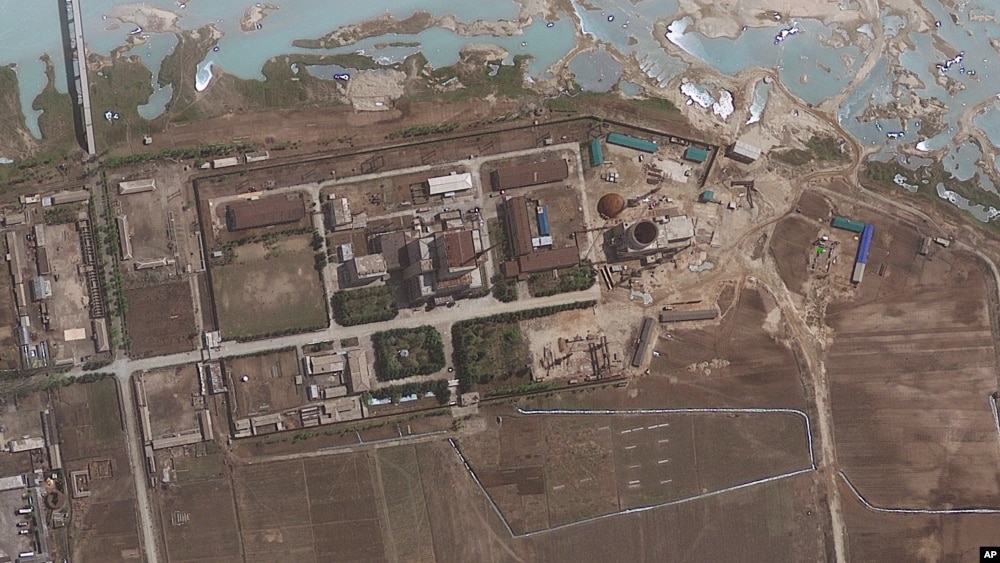IAEA: North Korea Apparently Building Nuclear Site

FILE – A satellite image shows the area around the Yongbyon nuclear facility in Yongbyon, North Korea.
North Korea appears to be renovating and building facilities at its Yongbyon nuclear site, a central element of its atomic weapons program, the U.N. nuclear agency’s head said on Monday.
A report by the Washington-based Institute for Science and International Security in April said satellite images showed that activity at the site’s main nuclear reactor may have resumed after a shutdown.
North Korea, which is believed to have carried out nuclear tests in 2006, 2009 and 2013, has not granted IAEA inspectors access to its facilities since 2009, reducing the agency to monitoring its nuclear activities from outside the country.
“We have observed renovation and construction activities at various locations within the site,” IAEA Director General Yukiya Amano told a closed-door meeting of his agency’s Board of Governors in Vienna, according to a text of his speech.
“These appear to be broadly consistent with the DPRK’s statements that it is further developing its nuclear capabilities,” he said, referring to North Korea’s official name, the Democratic People’s Republic of Korea.
Although North and South Korea recently averted a full-scale military confrontation, and agreed to improve ties after a rare exchange of artillery fire over their heavily fortified border, tensions on the Korean Peninsula remain high.
China, North Korea’s closest ally, called on Wednesday for a resumption of talks over Pyongyang’s nuclear program.
The so-called six-party talks — between China, the United States, Japan, Russia and the two Koreas — were last held more than six years ago despite numerous efforts to restart them.
The ISIS report in April said the main reactor at Yongbyon may be operating again at low power or intermittently, and that a centrifuge plant, a facility for the enrichment of uranium, had operated. It also said renovations might be imminent.
Amano did not say where within the Yongbyon site the renovation and construction activities were being carried out.
“We continue to monitor developments at the Yongbyon site, mainly through satellite imagery,” said Amano.
*** There is more:
WASHINGTON (AP) — North Korea is expanding its capacity to mine and mill uranium ore which could supply its nuclear weapons program or fuel nuclear reactors, according to new U.S. research.
The findings shed some light on how Pyongyang gets the raw material to fuel its nuclear ambitions that are raising international alarm.
The analysis is by Jeffrey Lewis, an arms control expert at the Monterey Institute of International Studies. It is being published Wednesday by the website 38 North, which specializes in North Korea.
Lewis writes that recent commercial satellite imagery, the latest from this May, shows that over the past year, North Korea has been modernizing a key facility next to its main uranium mine at the southern site of Pyongsan, not far from the frontier with rival South Korea.
That suggests North Korea is expecting to process significant amounts of uranium, although what it will do with the product remains unclear. A uranium mill is where uranium ore is turned into yellowcake, a key step before it is fabricated as reactor fuel or for enrichment in centrifuges.
Lewis says one possibility is that North Korea will enrich the uranium to expand its stockpile of nuclear weapons.
The North revealed nearly five years ago it has a uranium enrichment facility at its main nuclear complex at Nyongbyon, and there are signs the facility has since been expanded.
Another possibility, Lewis says, is that the North plans to produce fuel for an experimental light-water reactor under construction at its main nuclear complex at Nyongbyon and possible future reactors based on that model.
North Korea has conducted three nuclear test explosions since 2006 and its weapons stockpile could grow sharply in the coming years, analysts warn.
“The expansion of North Korea’s uranium mine and milling operation is one more piece of evidence pointing to Pyongyang’s nuclear ambitions, particularly a growing nuclear weapons stockpile that poses a clear threat to the United States, Northeast Asia and the international community,” said Joel Wit, a former State Department official and editor of 38 North.
International nuclear monitors were expelled from North Korea in 2009, so there’s scant independent information on its activities. But in 1992, North Korea declared to the International Atomic Energy Agency that it had two uranium mines and mills, including Pyongsan.
Lewis says Pyongsan appears to have operated intermittently over the past decade. Satellite images show spoil and residue from the mill has been dumped into a nearby pond that is unprotected and surrounded by farms, which would pose a health risk, he says.
Photos also show the mill has undergone significant refurbishment since 2014, with buildings being renovated and a terminus of a conveyor belt demolished and rebuilt.
